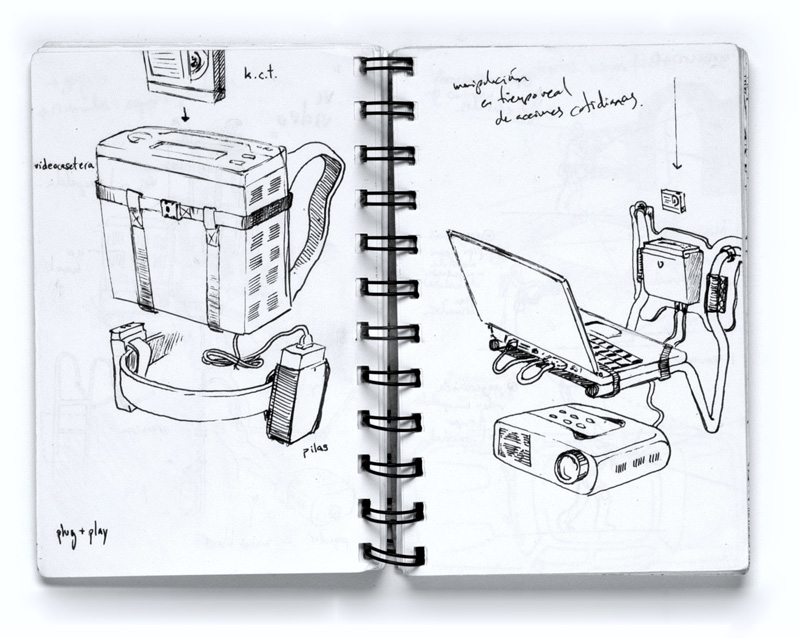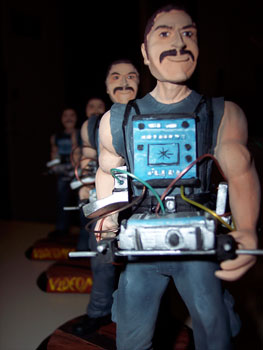Alter Ego, “The flâneur”
Fernando Llanos in his continuous approach to communicate, always through the experimentation of new techniques, assumes a protagonic role constantly looking for his alter ego, this is the way that the Videoman starts to take form. His project begins in 2001 as a vague idea, but it is until 2005 that Llanos starts creating his mobile Video interventions in different urban contexts like Brazil, Mexico, Spain and much others.
His art works can be read in different levels, where the importance lays not only on the fact that he trespasses the white cube by taking videos to open spaces, but also the artist becomes a piece of art, an object, a type of fetish.
Videoman is a nomad and media superhero, he walks through virtual and spatial borders. His luminous rays can be projected in any surface: walls, objects, screens and even people. He intervenes any type of scenario: markets, airports, stadiums, monuments, restaurants etc. He creates new concepts where the simple form of projecting in a screen is rethought and by this exercise he can reconstruct the image, as if the physical space was itself renovated.
Fernando Llanos recreates, in a way, the flâneuronce described by Walter Benjamin, this character, that through his wonderings experiments the city. By roaming the streets of a city the flâneur conceives the façades of houses like any other citizen would take the four walls of his home, the walls of buildings are his desk and the news paper stands are his library1.
The series of video interventions in public spaces are carried out in a direct and surprising way in order to capture the interest of all audiences confronting and involving them. Videoman creates interventions where technology is a mediation form of interactive communication processes. Due to their mobile nature (thanks to his equipment he is able to make use of his super powers) they are ephemeral. Most of the projections are linked to the local history of the specific city, he makes the audience active participants of the art work by filming their reactions and making them partly-protagonists, then he posts the videos on the internet in order to provoke further participation.
The Cervantino Festival in Guanajuato Mexico is a once a year cultural celebration, besides of all of the events that revolve around it, it is a street celebration, so Videoman captured all the drunk participants of this event as part of the Festival´s importance and projected the videos in Guanajuato´s downtown.
Videoman´s interventions are a form of transgression where the concept is thought of as a form of resistance, rebelliousness, protest, insurrection, subversion and independence. Transgression is a form of confronting the white cube. Georges Bataille mentions that transgression is a form of outlining imposed limits, it is a form of disapproving that witch is prohibited2.
A clear example of transgression in the work of Llanos is the video intervention he projected in the Salgado Filho airport, the nowhere place by excellence, where the white walls can remind us of the purity of a gallery. Airports are thought of as the most secure place, but in this occasion Videoman projected, within his provocative essence, different airplane crashes and failed landings transforming and transgressing common ideology, creating two contrasting narrative sequences. Paraphrasing the artist, this intervention meant a type of poetic terrorism in order to create a direct confrontation with people3.
Llanos uses images that can be considered political incorrect, he shows the other side of the truth that which becomes uncomfortable.
Videoman projects an existing image, he does not produce one himself but appropriates it, he does this to expose the degree to which nature is always implicated in a system of cultural values which assigns it a specific, culturally determined position.

Becoming an object of desire
Besides the importance of transgression, as I mentioned before, Llanos through his alter ego Videoman, is transformed in a piece of art, an object, a type of fetish. By making his projections he becomes part of the intervention, he is a fragment of the narrative and he becomes a moment within it.
In “The work of art in the age of mechanical reproduction”4 Walter Benjamin mentions that the “aura” has to do with the presence of the original, with authenticity, with the unique existence of the work of art in the place in which it happens to be. The presence of the artist in the work must be detectable; in this case the manifestation of the artist and the way he turns into the object of art itself is almost obvious.

As we piece together, or guess, or assume some meaning in the plot, we find that the meaning is he, you see Videoman as he sees himself.
Douglas Crimp analyzes the notion of presence in the photographic activity of postmodernism and mentions:
“To the notion of presence that is about being there, being in front of, a kind of presence that is ghostly and therefore is really an absence, the presence that is not there, I want to add the notion of presence as a kind of increment of being there, a ghostly aspect of presence that is its excess, its supplement”5.
The real importance of Videoman´s interventions talk about his absence or as Crimp puts it “his ghostly presence”, but we can constantly find this character trying to find himself as a representation within his art work.
The attempt to find the “real” Fernando Llanos is unfulfilable, just as it is for anyone, but what´s so interesting is the obsessive drive to find that identity. The artist becomes the object of art therefore his video interventions become auto referential.


The object therein becomes an object of desire, a fetish. As Batille would describe it, a meaningful object of the denial of the limits of all objects is therefor an object of desire6.
The common discourse about the fetishes is no more than the continuation of the traditional Christian discourse respecting idolatry.
The fetish is something personal, for which it´s truth is experienced as a substantial movement from the inside of the being until the self-limited morphology of an object found in the outside. Works of art are real fetishes only if they become personal materials, giving a significance and or importance to that which had none. The truth within the fetish resides in its status of a material incarnation.
In a way of reaffirming his condition of being as an object of desire that is in itself a fetish, Fernando Llanos created “Videoactionman”.
The continuous seduction of the notion of fetish and the form in which contemporary art seems to draw to the mobilization of the production of particular objects is a logic that can be found in the irrational economic system.
Videoactionman inserts itself in the economic circuit and then is descontextualized and recontextualized in the art world, this without loosing his condition of fetish.
Finally in his last step of becoming a fetish venerated by those he initially transgressed7 Videoman had his solo exhibition in Plataforma Bogotá (Laboratorio Interactivo de Arte, Ciencia y Tecnología de la Fundación Gilberto Alzate Avendaño) where most, if not all, of his work was exhibited.
The exhibition presented in 2011 included images of his actions, some of the videos of aerial destructions, a large amount of his sketches and also a wide series of his super action figures, posters, t-shirts post cards and other merchandising articles8.


Notes
[1] Walter Benjamin on the flâneur, http://www.arthurmag.com/magpie/?p=24207/09/2002, date of consult august 24 of 2008.
[2] Georges Bataille, El erotismo, México D.F., Tusquets, 2008, p.67.
[3] http://www.fllanos.com/vi_video/videos.html
[4] Walter Benjamin, The work of art in the age of mechanical reproduction, London, Penguin, 2008.
[5] Douglas Crimp, “The Photographic Activity of Postmodernism” in Cindy Sherman, Cambridge, Massachusetts, MIT Press, 2006, p. 27.
[6] Georges Bataille, Op.Cit.
[7] In his series of video interventions Fernando Llanos took video projections to the streets transgressing museums or galleries, but ended up presenting them inside the white cube.
[8] http://www.culturarecreacionydeporte.gov.co/portal/node/4601, this exhibition was also presented in Mexico and Argentina.
